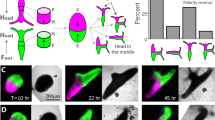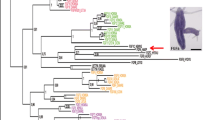Summary
Regeneration in hydra is considered to be morphallactic because it can occur in the absence of cell division. Whether DNA synthesis is required for regeneration or other repatterning events is not known. The question was investigated by blocking DNA synthesis with hydroxyurea and examining several developmental processes. Head regeneration, reversal of regeneration polarity and battery cell differentiation all took place in the absence of DNA synthesis. Hence, morphallactic regulation in hydra is independent of both DNA synthesis and mitosis.
Similar content being viewed by others
References
Berking S (1979) Control of nerve cell formation from multipotent stem cells in hydra. J Cell Sci 40:198–205
Bode HR, David CN (1978) Regulation of a multipotent stem cell, the interstitial cell of Hydra. Prog Biophys Mol Biol 33:198–206
Bode HR, Flick KM, Smith GS (1976) Regulation of interstitial cell differentiation in Hydra attenuata. I. Homeostatic control of interstitial cell population size. J Cell Sci 20:29–46
Campbell RD (1965) Proliferation in Hydra: An autoradiographic approach. Science 148:1231–1232
Campbell RD (1967) Tissue dynamics of steady state growth in Hydra littoralis. III. Behavior of specific cell types during tissue movements. J Exp Zool 164:379–392
Campbell RD (1973) Vital marking of single cells in developing tissues: India ink injection to trace tissue movements in Hydra. J Cell Sci 13:651–661
Campbell RD, David CN (1974) Cell cycle kinetics and development of Hydra attenuata. II. Interstitial cells. J Cell Sci 16:349–358
Clarkson SG (1969) Nucleic acid and protein synthesis and pattern regulation in hydra. II. Effect of inhibition of nucleic acid and protein synthesis on hypostome formation. J Embryol Exp Morphol 21:55–70
Cooke J (1973) Morphogenesis and regulation in spite of continued mitotic inhibition in Xenopus embryos. Nature 242:55–57
David CN (1973) A quantitative method of maceration of Hydra tissue. Wilhelm Roux's Arch 171:259–268
David CN, Campbell RD (1972) Cell cycle kinetics and development of Hydra attenuata. I. Epithelial cells. J Cell Sci 11:557–568
David CN, Murphy S (1977) Characterization of interstitial stem cells in hydra by cloning. Dev Biol 48:372–383
Diehl FA, Burnett AL (1965) The role of interstitial cells in the maintenance of hydra. III. Regeneration of hypostome and tentacles. J Exp Zool 158:299–318
Fujisawa T, David CN (1981) Commitment during nematocyte differentiation in Hydra. J Cell Sci 48:207–222
Gambari R, Marks P, Rifkind R (1979) Murine erythroleukemia cell differentiation: relationship of globin gene expression and of prolongation of G1 to inducer effects during G1/early S. Proc Natl Acad Sci USA 76:4511–4515
Graham TM (1974) DNA synthesis and effects of hydroxyurea on regenerating Hydra. Trans Ill State Acad Sci 67:222–227
Hicklin J, Wolpert L (1973) Positional information and pattern regulation in Hydra: The effect of radiation. J Embryol Exp Morphol 30:741–752
Humason GL (1962) Animal tissue techniques. Freeman WH and Company, p 569
Jones PA, Taylor SM (1980) Cellular differentiation, cytidine analogs and DNA methylation. Cell 20:85–93
Lesh-Laurie GE, Brooks DC, Kaplan ER (1976) Biosynthetic events of hydroid regeneration. I. The role of DNA synthesis during tentacle elaboration. Wilhelm Roux's Arch 180:157–174
Linkhart T, Clegg C, Hauschka S (1980) Control of mouse myoblast commitment to terminal differentiation by mitogens. In: Cunningham D (eds) ICN/UCLA symposium un control of cell division and differentiation. Keystone, Colorado
Loomis WF, Lenhoff HM (1956) Growth and sexual differentiation of Hydra in mass culture. J Exp Zool 132:555–573
MacWilliams HK (1983) Hydra transplantation phenomena and the mechanism of Hydra head regeneration. II. Properties of head activation. Dev Biol 96:239–257
MacWilliams HK, Bonner JT (1979) The prestalk-prespore pattern in cellular slime molds. Differentiation 14:1–22
Marcum BA, Campbell RD (1978a) Development of hydra lacking nerves and interstitial cells. J Cell Sci 29:17–33
Marcum BA, Campbell RD (1978b) Developmental roles of epithelial cell lineages in Hydra: analysis of chimera. J Cell Sci 32:233–247
Marcum BA, Campbell RD, Romero J (1977) Polarity reversal in nerve-free hydra. Science 197:771–773
Morgan TH (1901) Regeneration in the egg, embryo and adult. Am Natur 35:949–973
Nadal-Ginard B (1978) Commitment, fusion and biochemical differentiation of a myogenic cell line in the absence of DNA synthesis. Cell 15:355–364
Park HD, Ortmeyer AB, Blankenbaker DP (1970) Cell division during regeneration in Hydra. Nature 177:617–619
Razin A, Riggs AD (1980) DNA methylation and gene function. Science 210:604–610
Rubin DI, Bode HR (1982a) The aberrant, a morphological mutant of Hydra attenuata, has altered inhibition properties. Dev Biol 89:316–331
Rubin DI, Bode HR (1982b) Both the epithelial cells and the nerve cells are involved in the head inhibition properties in Hydra attenuata. Dev Biol 89:332–338
Sacks PG, Davis LE (1979) Production of nerveless Hydra attenuata by hydroxyurea treatments. J Cell Sci 37:189–203
Schaller HC, Gierer G (1973) Distribution of the head-activating substance in hydra and its localization in membranous particles in nerve cells. J Embryol Exp Morphol 29:39–52
Smith GH, Vonderhaar BK (1981) Functional differentiation in mouse mammary gland epithelium is attained through DNA synthesis, inconsequent of mitosis. Dev Biol 88:167–179
Takano J, Sugiyama T (1984) Genetic analysis of developmental mechanisms in hydra. XII. Analysis of chimeric hydra produced from a normal and a slow-budding strain (L4). J Embryol Exp Morphol 80:155–173
Venugopal G, David CN (1981) Nerve commitment in Hydra. II. Localization of commitment in S. Dev Biol 83:361–365
Vonderhaar B, Topper Y (1974) A role of the cell cycle in hormone-dependent differentiation. J Cell Biol 63:707–712
Wilby OR, Webster G (1970) Experimental studies on axial polarity in Hydra. J Embryol Exp Morphol 24:595–613
Yaross MS, Baca BA, Chow MH, Bode HR (1982) Commitment of Hydra interstitial cells to nerve cell differentiation occurs by late S-phase. Dev Biol 89:425–436
Author information
Authors and Affiliations
Rights and permissions
About this article
Cite this article
Cummings, S.G., Bode, H.R. Head regeneration and polarity reversal inHydra attenuata can occur in the absence of DNA synthesis. Wilhelm Roux' Archiv 194, 79–86 (1984). https://doi.org/10.1007/BF00848347
Received:
Accepted:
Issue Date:
DOI: https://doi.org/10.1007/BF00848347




